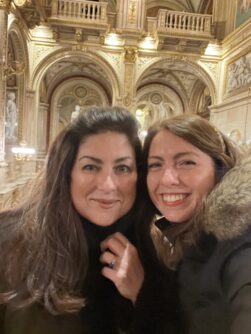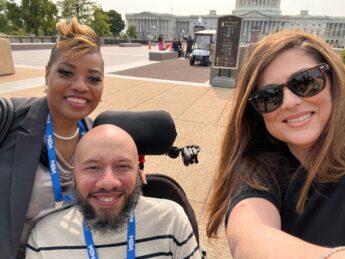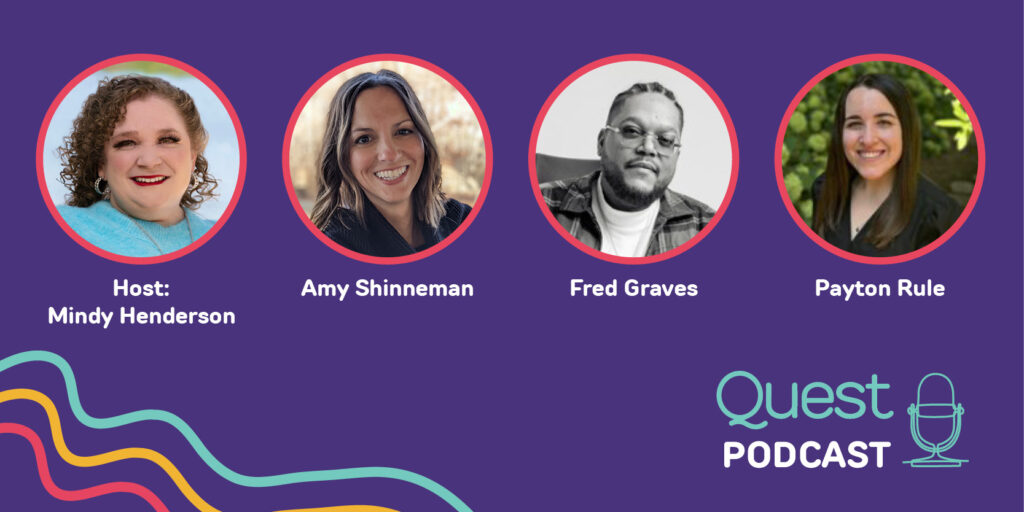
The Journey to Self-Acceptance and Empowerment
By Rebecca Hume | Thursday, September 7, 2023

Morgan Roth, Chief Marketing Officer at MDA
When Morgan Roth went to see the new Barbie movie with her daughter, she was not expecting the film to have a significant, personal, and powerful impact on her – but that is exactly what it did. The film’s motifs resonated deeply with Morgan, inspiring her to write and publish a personal essay on LinkedIn, sharing her own message of empowerment and resilience.
Morgan, the Chief Marketing Officer at MDA, had previously opted to keep her Charcot-Marie Tooth (CMT) diagnosis a private one. Motivated by the parallels in Barbie’s quest for self-acceptance and her own journey toward embracing imperfections and navigating the challenges of living with a rare disease, Morgan recognized an opportunity to empower others through her own story.
“This neurological disorder, impacting muscle strength and sensation, poses physical challenges that defy contemporary (well, forever) expectations of normalcy. CMT can manifest as slight, moderate, or profound differences in the appearance and performance of our feet, creating a unique journey of acceptance for all of us,” Morgan wrote in her essay. “As I continue to navigate emotional and physical complexities of CMT, I discovered a resonance between Barbie’s narrative and my own pursuit of self-acceptance. As Barbie’s transformation inspires a generation to embrace beauty on their terms, CMT empowers me to perceive strength in my uniqueness and to celebrate the authenticity that defines me.”
Interestingly, this was not the first time that a film led Morgan to a life-altering epiphany.
A unique journey to diagnosis
As a child, Morgan was aware that her feet were shaped differently than other people’s feet and that she fell more often than others. When she was 12 years old, her pediatrician sent her to a neurologist to undergo a battery of tests. At that time, Morgan viewed the issues with her feet as cosmetic and simply yearned for “prettier” feet. After a few days undergoing tests in the hospital, Morgan’s parents told her that there was nothing to be done and that she was fine. The underlying message ascertained by young Morgan was that she should not allow her feet to impact her life’s path and that she should just be grateful. Morgan assumes that her parents felt assured by the doctors that she would be capable of pursuing her dreams and that they may have been hesitant to limit her concept of potential by labeling her disability. The results of her tests and potential barriers or accommodations were not discussed again as a family.

Morgan and her daughter, Bridget, at the opera in Vienna, Austria.
Over thirty years later, after attending McGill University in Montreal and paving an impressive career path through broadcast journalism, international work, and eventually finding her passion and niche in the non-profit sector, Morgan happened to stumble across a documentary while channel-surfing. “Bernadette”, a documentary about a young woman living with CMT, grabbed Morgan’s interest with the promotion line: “She is 1 in 2,500 living with the most common disease you’ve never heard of.”
“I don’t know why I watched it,” Morgan says. “And then I had this wild epiphany: ‘Oh my gosh, that’s me!’ Bernadette has a more severe form of CMT, but I recognized myself when she was describing the foot weakness and the strength and walking issues.” This was the first time that Morgan realized that a neuromuscular disease was the cause of the symptoms she had been living with all of her life.
Morgan researched the neurologist who she had seen as a child, discovering that he was one of the seminal neurologists researching CMT at the time and that he had since passed away. She began a quest to locate records from the multitude of tests that she had undergone decades ago. She has not been able to find those records, and while she continues to consider undergoing new testing (which is much less invasive than it was forty years ago), she also admits that she struggles at times on her journey to accept her diagnosis and embrace that CMT is part of her story. There is a universal aspect to the very personal struggle of self-acceptance (with or without a disability) and it is a path that every person travels at their own pace – but, through connection and community, that path can be made less challenging, less narrow, and less daunting.
The power in sharing your story
The Barbie film is not the only recent source of empowerment and epiphany that Morgan has found on her journey. In fact, her career path has led her into the heart of the neuromuscular community. Currently serving in an executive leadership role with the MDA, Morgan is professionally at the forefront of the movement to increase treatments, accommodations, and empowering policy for those living with neuromuscular disease. The realization that her personal experience can also serve as a powerful medium for change provided deeper motivation to be candid about her disability. She shares that finding the bravery to embrace her diagnosis and to share her story has provided a strong sense of liberation and a deeper sense authenticity.

Morgan at Capitol Hill with ALS advocate, Maceo Carter, and his family
“Working in the neuromuscular disease space, I was starting to feel like I was really disingenuous by not being brave enough to say that I have a rare disease, I have a neuromuscular disease. How could I be hiding what I have in the face of all of these people who have this imperative to talk about their rare disease?” Morgan says. “They are working so hard for the neuromuscular disease community, and I am a leader in that movement… how could I not carry the flag publicly and proudly? So, I felt that it was unethical not to be candid with my community and not to be a part of that fight for progress authentically and organically as somebody who is living with CMT.”
A large aspect of the fight for progress in the disability community is the need for pivotal change in society’s view. The need for significant transformation in societal misconceptions of individuals living with disabilities is a cause that Morgan is passionate about, especially when it comes to disabilities that are not always readily visible.
“We as humans love to compartmentalize people. To so many people, disability means a wheelchair or braces or a guide dog. It is important to be able to normalize all of those things. But it is also important to normalize that not everybody with a disability or who needs accommodations necessarily makes that visible,” she says.
The path to self-acceptance
Many individuals living with CMT use ankle-foot orthoses (AFOs), which are braces that increase safety and mobility when walking. These are braces that are easily visible with shorts but can also go unnoticed with long pants. While Morgan does not currently use AFOs, she recognizes that the personal decision to display braces or not to display braces is a choice that offers empowerment.
“Wherever you land and wherever you are comfortable, whether showing or not, you still represent this community,” she says. “There is merit in however you are comfortable displaying your disability or accommodations that you use.” Words that resonate the core message that self-acceptance is about self – not about how the world might or might not perceive you.

Morgan and her daughter, Bridget, at the Louvre Museum in Paris, France.
On her personal journey to self-acceptance while living with a neuromuscular disease, Morgan has found that the most impactful lesson she has learned about herself is the power of resilience. She hopes that sharing her story with others who are on a similar journey can offer a supportive reminder of the many ways in which they are growing every day, that they are not alone on their journey, and that there is a plethora of opportunities that exist for them to succeed in the world despite their disability.
“Most people in the NMD community will probably not be an NFL quarterback, but you could get a job in the NFL if football is your passion,” Morgan says. “It is about applying your mind and your attitude – and being part of the work that we are all supporting you in, in changing attitudes and making more opportunities readily accessible. We have some really sensational people who have achieved limitless success guiding our way.”
As Morgan shared in her essay about the Barbie film, her own journey involves redefining her sense of normalcy and challenging society’s preconceived notions of physical ability. As the disability community and its advocates work hard to change the many societal misconceptions about ability and disability that exist in day-to-day life, in media, and in the workplace, their actions for change strive to empower others to live a life without limits.
“There are no limits. The only limits are in your mind,” she says. “It’s not magical thinking, you still have to work hard. You still have to push down doors and understand that success comes over time. You have to be smart and strategic, like everyone else planning a career – but it can happen for you too. Use the people who have gone in front of you and always remember the people coming behind you. Your capacity to progress and do whatever you want to do with your life is governed by your mind and your spirit, not your body.”
Next Steps and Useful Resources
- Read Morgan’s personal essay on LinkedIn here.
- Stay up-to-date on Quest content! Subscribe to Quest Magazine and Newsletter.
Disclaimer: No content on this site should ever be used as a substitute for direct medical advice from your doctor or other qualified clinician.




